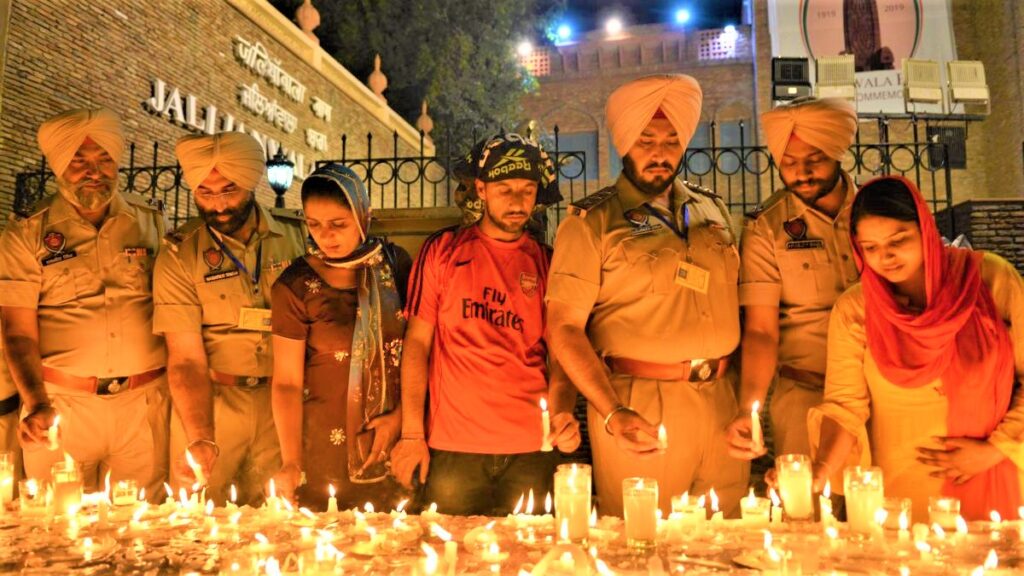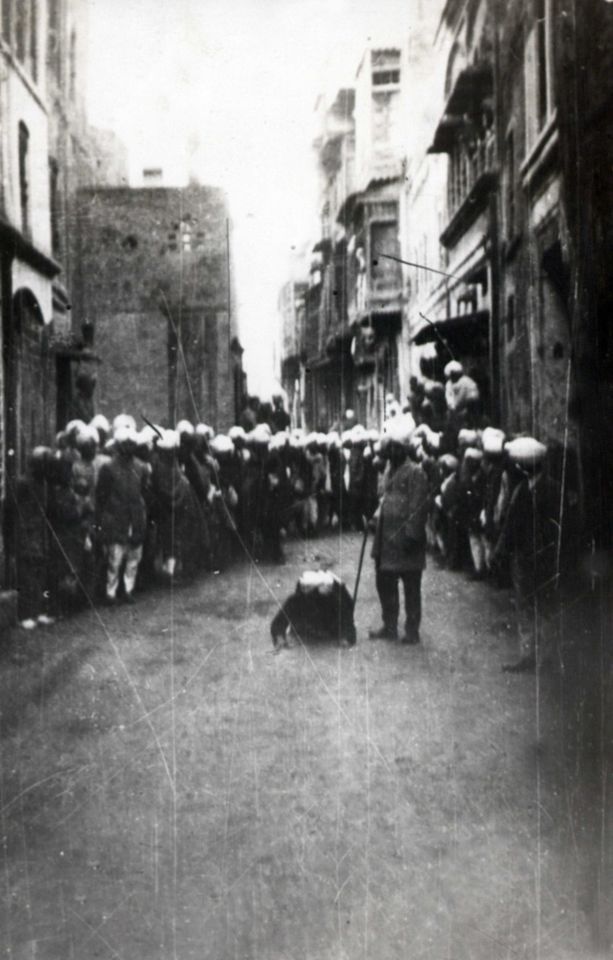Barbarism Practised by the Epicentre of Civilisation (Part 1)
TRANSCEND MEMBERS, 14 Feb 2022
Prof Hoosen Vawda – TRANSCEND Media Service
The Brutal Massacre at Jallianwala Bagh, Amritsar by the British Raj in India
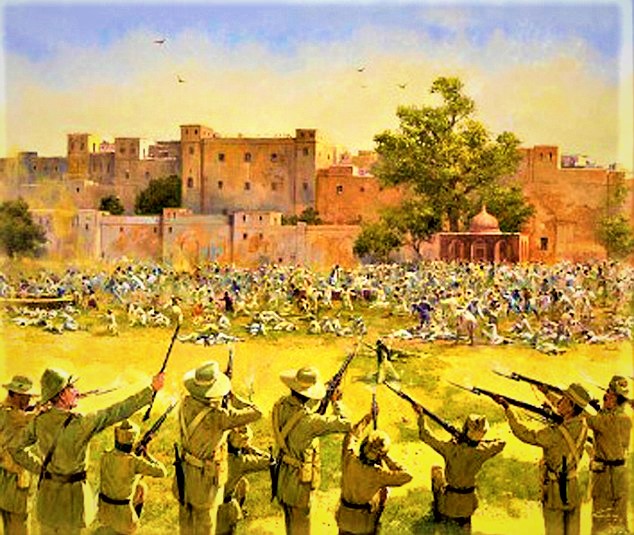
A painting of the Jallianwala Bagh massacre ( Amritsar Massacre ) in which at least 379 died. Painting taken from internet – no credit available
The day of 31st July 1940 has come, as Udham Singh, a person of Indian origin, a Sikh from the neighbourhood of Pilbad in Sunam[1], around 130 miles south of Lahore, in British India, is escorted from his cold prison cell by the warden and two accompanying men in Pentonville Prison, London. As he walks own the passageway, he is clutching a folded piece of paper with a picture of Bhagat Singh[2], his idol, which he clasped in his palms while he was being handcuffed, as he is led up to the gallows in the jail. The charge sheet was read by the warden as “death penalty by hanging for the premeditated murder of an 80-year-old Michael O’ Dwyer”, the former Lieutenant-Governor of the Punjab in the British Raj in India on 13th March 1940 in London. The post mortem confirm that the bullet went through his 80-year-old heart, killing his almost instantaneously.[3]
The warden placed a black hood on his head and the noose around his neck, At the appointed time, the trapdoor was released and the weight of the stout Udham Singh, caused the audible cracking sound from the breaking of his atlanto-axial joint of his neck[4], transecting his spinal cord, which could be heard by those present at the execution, as his body plunged down from the gallows. Udham Singh’s body quivered violently for 90 seconds, before it went limp. He was interred in the prison graveyard, contrary to his Hindu belief of cremation. Thus, ending the sad life of a brave Sikh, who was a hero of the fight for independence of India from the brutal British imperialism, another seven years later. Britain oppressed Indians for almost 250 years, officially from 1857 following the sepoy mutiny and prior to that ruled by the British East India Company from 24th August 1608,[5] when the British first set their feet on the periphery of India in Surat, with the purpose of trading. The British did not just parasitise all the wealth or heritage,[6] but also hollowed the rich Indian culture and mastered their divide and rule strategy amongst the happy coexistence between the Hindus, Muslims and Sikhs, resulting in the end of this social cohesion, the horrendous climax being the Partition Genocide. following Independence of India on 15th August 1947.[7] [8]
It was only in 1970 , due to some unbelievably agile diplomatic footwork, Indira Gandhi[9] got Udham Singh’s body disinterred from Pentonville and the body returned to India, where the mortal remains received a hero’s welcome. His body was toured around Punjab, and people lined the streets, weeping and crying out his name. His ashes were symbolically dispersed among Hindu, Muslim and Sikh shrines. Postage stamps were issued with Udam Singh’s face, and streets in Punjab were eponymously named . On Martyrs’ Day, the grateful Indians, often globally, who have not forgotten the thousands killed by the British Raj in India, light candles in front of his image and his statue in Jallianwala Bagh, in Amritsar, garlanded with marigolds[10].
Udham Singh was born ‘Sher Singh’, on 26th December 1899 to Tehal Singh, a low-caste, low-skilled low-paid manual labourer and his wife Narain Kaur.[11]
On the 4th of June 1940, he had been arraigned before Mr. Justice Atkinson at the Central Criminal Court, the Old Bailey. Udham Singh was charged with the murder of Sir Michael O’Dwyer, the former Lieutenant-Governor of the Punjab who had approved of the action of Brigadier-General R.E.H. Dyer at Jallianwala Bagh, Amritsar on April 13, 1919, which had resulted in the massacre of hundreds of men, women and children and left over 1,000 wounded during the course of a peaceful political meeting. The killing of O’Dwyer occurred at the Caxton Hall, Westminster, London.
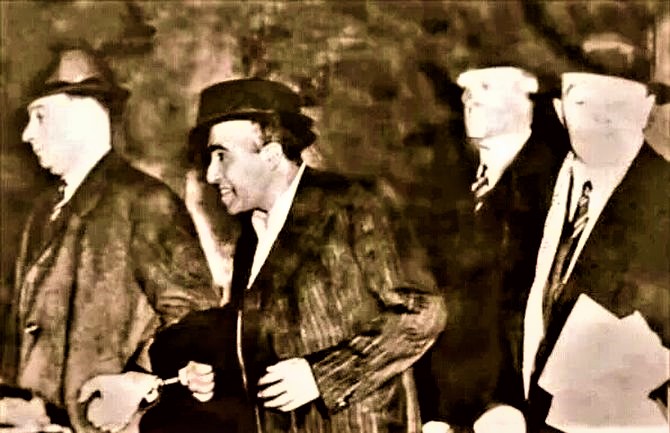
The immediate arrest of “Ram Mohammad Singh Azad” as named, after the killing of Michael O’Dwyer, seen here happy at achieving his mission, after 20 long years and handcuffed by the London Police.
While in custody, he called himself “Ram Mohammad Singh Azad”: the first three words of the name reflect the three major religious communities of Punjab: the Hindus, Muslims, and Sikhs; the last word “azad”, literally meaning “free”, reflects his justified anti-colonial sentiments.[12]
The trial of Udham Singh lasted for two days, he was found guilty and was given the death sentence. On the 15th July 1940, the Court of Criminal Appeal heard and dismissed the appeal of Udham Singh against the death sentence.
As is the case, prior to passing the sentence Mr. Justice Atkinson asked Udham Singh whether he had anything to say. Replying in the affirmative he started to read from prepared notes. The judge repeatedly interrupted Udham Singh and ordered the press not to report the statements, made by the Udham Singh. Both in Britain and ironically in India, as in 1940 it was still a British colony, the governments made strenuous efforts to ensure that the minimum publicity was given to the trial. Reuters were officially approached for this purpose, as well as not to print Martyr Udham Singh’s statements at the trial.
Summarising Udham Singh’s early background, it was an extremely sad odyssey. His father, Tehl Singh, was born into a poor peasant family and worked as a Railway Gate Keeper at the railway level crossing at Village Uppali. Udham Singh was born on 28th December, 1899 at Sanam, Sangrur District, Punjab. After the death of his father Udham Singh was brought up in a Sikh orphanage in Amritsar. The massacre at Jallianwala Bagh in 1919 was deeply engraved in the mind of the future martyr. At the age of 16 years Udham Singh defied the curfew and was wounded in the course of retrieving the body of the husband of one Rattan Devi in the aftermath of the slaughter. Subsequently Udham Singh travelled abroad in Africa, the United States and Europe. Over the years he met Lala Lajpat Rai, Kishen Singh and Bhagat Singh, whom he considered his guru and ‘his best friend’. In 1927 Udham Singh was arrested in Amritsar under the Arms Act. The impact of the Russian revolution on him is indicated by the fact that amongst the revolutionary tracts found by the raiding party was Rusi Ghaddar Gian Samachar. After serving his sentence and visiting his home town, Udham Singh resumed, his travels abroad. If it was the Jallianwala Bagh massacre which provided the turning point of his life which led him to avenge the dead, it was Bhagat Singh who provided him with the inspiration to pursue the path of revolutionary struggle.
After his arrest, in a statement made on 13th March1940 Udham Singh said: “I just shot to make protest. I have seen people starving In India under British Imperialism. I done it, the pistol went off three or four times. I am not sorry for protesting. It was my duty to do so. Put some more. Just for the sake of my country to protest. I do not mind my sentence. Ten, twenty, or fifty years or to be hanged. I done my duty.” The British courts were able to silence for long the last words of Udham Singh. At last the speech has been released from the British Public Records Office. Shorthand notes of the Statement made by Udham Singh after the Judge had asked him if he had anything to say as to why sentence should not be passed upon him according to Law. Facing the Judge, he exclaimed, ‘I say down with British Imperialism. You say India do not have peace. We have only slavery. Generations of so called civilisation has brought for us everything filthy and degenerating known to the human race. All you have to do is read your own history. If you have any human decency about you, you should die with shame. The brutality and bloodthirsty way in which the so-called intellectuals who call themselves rulers of civilization in the world are of bastard blood…” After Singh had left the dock, the Judge turned to the Press and said: ‘I give a direction to the Press not to report any of the statement made by the accused in the dock. You understand, members of the press?’[13]
It is also important to understand how the killing of O ‘Dwyer and the subsequent death by hanging of Udham Singh unfolded. The history behind this gory chapter of the British Raj in India is closely intertwined with the Indian freedom struggle. The statement often made is that “Gandhi got us freedom without shedding blood” This is certainly not the case when the sacrifices and blood of martyrs was so deliberately buried under political correctness, generated both by the British hypocrisy as well as the upper-class. indigenous Indians. who were reversed radicalised by the doctrine of “His Master’s Voice”, creating “clones” of the colonisers amongst the Indians and supporting the British, against their own people. The effect of this is still evident. even today, in India with recurrent emergence of sectarian violence. In fact, in the past week, the Hijab Protests by the Muslim girls in the province of Karnataka,[14] runs the danger of a fully blown religious riots, with massive casualties on both sides, with bloodshed, to the delight of politicians. These problems emanate from the policy of divide and rule of the British in ensuring that the religious differences between Muslims and Hindus was maximally exploited to the benefit of the colonisers. India, as a nation, cannot forget the bloodshed on that fateful day of slaughter on 13th April 1919, when innocent, protesting civilians were slaughtered by military gunfire at a meeting platform, in Amritsar, nor can it afford to forget the religious cleansing of both the Hindu and Muslims during the Partition in 1947.
Amritsar, is historically known as Rāmdāspur, It is geographically located in the Majha region[15] of the Punjab. The Bhagwan Valmiki Tirath Sthal situated at Amritsar is believed to be the Ashram site of Maharishi Valmiki, the writer of Ramayana. This was also the place of Ramtirth ashram where Lava and Kusha, the twin sons of Rama, were born to Sita Devi, while she was in forced isolation in a heritage by Rama. There is also a tree here that marks the place where the ritual horse from Ashvamedha Yagna of Lord Rama was captured by Lava and Kusha. Furthermore, Guru Ram Das Sahibji, the fourth Sikh guru is credited with founding the holy city of Amritsar in the Sikh tradition.[16] The town grew to become the city of Amritsar, and the pool area grew into a temple complex after his son built the gurdwara Harmandir Sahib, and installed the scripture of Sikhism inside the new temple in 1604. Such is the auspicious history of Amritsar in Sikhism as well as Hinduisms based on the Ramayana the holy Hindu scripture.
Sadly, Amritsar is also the setting, when on 13th April 1919 hundreds of innocent Indians were massacred by the British at the Jallianwala Bagh, on the orders of Reginald Edward Harry Dyer. No event within living memory, can ever make so deep and painful an impression on the Indian subjects than the history or the very thought of massacre of innocents at Amritsar. The ruthless execution has no parallels and this Nation suffered economically more severely from the World war despite no direct participation. It was the cruel, psychopathic, General Dyer who had earlier written a spirited account of his campaign of annihilation against some nomad tribes on the frontier of South-East Persia and Baluchistan. in 1916.
During World War I most Indians supported Britain’s war effort on the assumption that some form of self-government would be granted at the end of hostilities. Instead, in March 1919 they got the Rowlatt Act, officially called Anarchical and Revolutionary Crimes Act, which gave the British Indian government draconian powers, including that of internment. In response, Mohandas Karamchand Gandhi[17] began a nationwide satyagraha[18] or non-violent protest. Nonetheless, violence erupted in Delhi and in the Punjab, where Sir Michael (‘Micky’) Francis O’Dwyer had been lieutenant-governor since 1912.[19]
On 9 April 1919 the Hindu festival of Ram Naumi[20] was celebrated in Amritsar with remarkable friendliness between Hindus and Muslims, interpreted as a political act by the authorities. O’Dwyer ordered Miles Irving, deputy commissioner in Amritsar, to arrest and deport Dr Kitchlew [21]and Dr Satya Pal, the local organisers of the satygraha. As a result, on 10 April protesters stoned troops, who opened fire, killing twenty people. The city erupted in rioting and five Europeans were killed. Miss Sherwood of the City Mission School was attacked in the street and left for dead. Terrified women and children crowded into the Gobindgarh Fort. On 11th April 1919, Brigadier General ‘Rex’ Dyer, commander of the Jullundar Brigade of the Indian Army, arrived to take control.
Dyer’s most infamous edict in the wake of the massacre was the so-called ‘crawling order’ whereby Indians had to crawl on all fours past the spot where mission school teacher Miss Sherwood had been attacked on 10th April 1919, a photograph in the National Army Museum, London, confirms this action required by Indians.[22]
The gory massacre was to occur and make Baisakhi day, 13th April 1919, the Sikh New Year’s Day, a tragic day, for on that day, local residents in Amritsar decided to hold a meeting to discuss and protest against the confinement of Dr Satya Pal [24]and Dr Saifuddin Kitchlew, two pro-Indian, independence leaders,[25] who were arrested when they went to peacefully meet the local authorities. People were also protesting implementation of the Rowlatt Act[26], which armed the British government with powers to detain any person without trial. The gathering in the Jallianwala Bagh was no violent crowd, It had a mix of men, women and children, gathered in a park walled on all sides having a few small gates. It was to be a peaceful meeting of peasants and people and included pilgrims visiting the famous Sikh Golden Temple in Amritsar.For one man, Brigadier-General Reginald E.H. Dyer it was not a peaceful assembly. He entertained himself, the thoughts of a major insurrection and thus he banned all meetings. On hearing that thousands had gathered in the park, Dyer went with fifty riflemen to a raised bank and ordered them to shoot at the crowd. Dyer continued the firing for about ten minutes, till the ammunition supply was almost exhausted; Dyer stated that 1,650 rounds had been fired, a number which seems to have been derived by counting empty cartridge cases picked up by the troops. The Jallianwala Bagh could only be exited on one side, as its other three sides were enclosed by buildings. After blocking the exit with his troops, he ordered them to shoot at the crowd, continuing to fire even as the protestors tried to flee. The troops kept on firing until their ammunition was exhausted.[27] Estimates of those killed varied between 379 and 1500+ civilians[28] and over 1,200[29] other people were injured of whom 192 were seriously injured.[30]
Additionally, it was reported that on Sunday, 13th April 1919, Dyer, was convinced that a major insurrection would take place, banned all meetings. This notice was not widely disseminated, and many villagers gathered in the Bagh to celebrate the important Sikh festival of Baisakhi, and peacefully protest the arrest and deportation of two national leaders, Dr Satya Pal and Dr Saifuddin Kitchlew. At 9:00 on the morning of 13th April 1919, the traditional festival of Baisakhi[31], Reginald Dyer, the acting military commander for Amritsar and its environs, proceeded through the city with several city officials, announcing the implementation of a pass system to enter or leave Amritsar, a curfew beginning at 20:00 that night and a ban on all processions and public meetings of four or more persons. The proclamation was read and explained in English, Urdu, Hindi, and Punjabi, but few paid it any heed or appear to have learned of it later.[32] Meanwhile, local police had received intelligence of the planned meeting in the Jallianwala Bagh through word of mouth and plainclothes detectives in the crowds. At 12:40, Dyer was informed of the meeting and returned to his base at around 13:30 to decide how to manage it.[33]
By mid-afternoon, thousands of Indians had gathered in the Jallianwala Bagh, near the Harmandir Sahib in Amritsar. Many who were present had earlier worshipped at the Golden Temple, and were passing through the Bagh on their way home. The Bagh, which in Hindi means a garden, was and remains today an open area of six to seven acres, roughly 200 yards by 200 yards in size, and surrounded on all sides by walls roughly 10 feet in height. Balconies of houses three to four stories tall overlooked the Bagh, and five narrow entrances opened onto it, several with lockable gates. During the rainy season, it was planted with crops, but served as a local meeting and recreation area for much of the year.[34] In the centre of the Bagh was a samadhi (cremation site) and a large well partly filled with water which measured about 20 feet in diameter.[35] Apart from pilgrims, Amritsar had filled up over the preceding days with farmers, traders, and merchants attending the annual Baisakhi horse and cattle fair. The city police closed the fair at 14:00 that afternoon, resulting in an even larger number of people drifting into the Jallianwala Bagh.
Dyer arranged for an aeroplane to overfly the Bagh and estimated the size of the crowd, that he reported was about 6,000, while the Hunter Commission estimates a crowd of 10,000 to 20,000 had assembled by the time of Dyer’s arrival.[36] Colonel Dyer and Deputy Commissioner Irving, the senior civil authority for Amritsar, took no actions to prevent the crowd assembling, or to peacefully disperse the crowds. This would later be a serious criticism levelled at both Dyer and Irving. An hour after the meeting began as scheduled at 17:30, Colonel Dyer arrived at the Bagh with a group of 50 troops, including 25 Gurkhas of 1/9 Gurkha Rifles (1st battalion, 9th Gurkha Rifles), 25 Pathans and Baluch and 59th Sindh Rifles.[37] Fifty of them were armed with .303 Lee–Enfield bolt-action rifles.[38] These rifles, commonly known as the.303 SLME (Short Magazine Lee Enfield) or just 303, is a bolt action, magazine-fed rifle that served the English military and that of the Commonwealth since 1895 and saw action in both World War 1 and World War II. Dyer may have specifically chosen troops from those ethnic groups due to their proven loyalty to the British. He had also brought two armoured cars armed with machine guns; however, the vehicles could not enter the compound through the narrow entrances. The Jallianwala Bagh was surrounded on all sides by houses and buildings and had only five narrow entrances, most kept permanently locked. The main entrance was relatively wide, but was guarded heavily by the troops backed by the armoured vehicles so as to prevent anyone from escaping from the confines of the Bagh.
Dyer, without warning the crowd to disperse, blocked the main exits and ordered his troops to begin shooting toward the densest sections of the crowd in front of the available narrow exits, where panicked crowds were trying to leave the Bagh. Firing continued for approximately ten minutes. Unarmed civilians including men, women, elderly people and children were killed. This incident came to be known as the Amritsar Massacre, ordered and executed by the civilized British. Cease-fire was ordered only when ammunition supplies were almost exhausted.[39] He stated later that this act “was not to disperse the meeting but to punish the Indians for disobedience.”[40]
The following day Dyer stated in a report that “I have heard that between 200 and 300 of the crowd were killed. My party fired 1,650 rounds”, he proudly announced.[41]
Apart from the many deaths directly from the shooting, a number of civilians demised in the stampedes at the narrow gates or by jumping into the solitary well on the compound to escape the shooting. A plaque, placed at the site after independence, states that 120 bodies were removed from the well. Dyer pushed the curfew time earlier than the usual time; therefore, the wounded could not be moved from where they had fallen and many more who had been injured, then died during the night.[42]
On 14 October 1919, after orders issued by the Secretary of State for India, Edwin Montagu, the Government of India announced the formation of a committee of inquiry into the events in Punjab. Referred to as the Disorders Inquiry Committee, it was later more widely known as the Hunter Commission[43]. It was named after the chairman, William, Lord Hunter, former Solicitor-General for Scotland and Senator of the College of Justice in Scotland. The stated purpose of the commission was to “investigate the recent disturbances in Bombay, Delhi and Punjab, about their causes, and the measures taken to cope with them”.[44]
Dyer further reiterated his belief that the crowd in the Bagh was one of “rebels who were trying to isolate my forces and cut me off from other supplies. Therefore, I considered it my duty to fire on them and to fire well”.[45] However, after Mr. Justice Rankin[46] had questioned Dyer, Sir Chimanlal Setalvad[47] enquired: Sir Chimanlal: Supposing the passage was sufficient to allow the armoured cars to go in, would you have opened fire with the machine guns? Dyer: I think probably, yes. Sir Chimanlal: In that case, the casualties would have been much higher? Dyer: Yes.[48] These responses of Dyer, indicate the acrimony against Indians, still prevalent today, by the “civilized British”.
A lengthy report concluded that:
- Lack of notice to disperse from the Bagh, in the beginning, was an error.
- The length of firing showed a grave error.
- Dyer’s motive of producing a sufficient moral effect was to be condemned.
- Dyer had overstepped the bounds of his authority.
- There had been no conspiracy to overthrow British rule in the Punjab.
- The minority report of the Indian members further added that:
-
- Proclamations banning public meetings were insufficiently distributed.
- Innocent people were in the crowd, and there had been no violence in the Bagh beforehand.
- Dyer should have either ordered his troops to help the wounded or instructed the civil authorities to do so.
- Dyer’s actions had been “inhuman and un-British” and had greatly injured the image of British rule in India.
The Hunter Commission did not impose any penal or disciplinary action because Dyer’s actions were condoned by various superiors and later upheld by the Army Council.[49] The Legal and Home Members on the Viceroy’s Executive Council ultimately decided that, though Dyer had acted in a callous and brutal way, military or legal prosecution would not be possible due to political reasons. However, he was finally found guilty of a mistaken notion of duty and relieved of his command on 23rd March 1920. He had been recommended for a CBE as a result of his service in the Third Afghan War[50]; this recommendation was cancelled on 29 March 1920. Dyer was removed from duty and forced to retire. However, he became a celebrated, national hero for killing Indians, in an act of supreme, barbaric oppression, in Britain amongst people with connections to the British Raj.
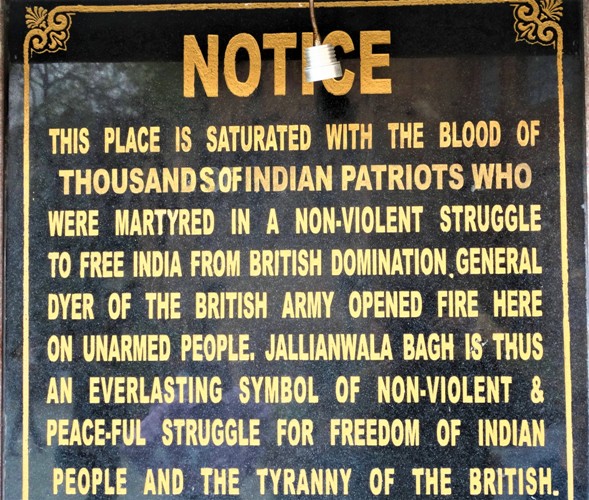
A plaque in memory of the Jallianwala Bagh Massacre on 13th April 1919 under Reginald Dyer’s orders to his troops
The names of the senior British Officers involved are confusing, as there were two of these civilised, British barbarians: Michael O’Dwyer, the British Lieutenant-Governor of Punjab who approved the action and Brigadier-General Reginald E.H. Dyer who executed the brutal massacre, against harmless people.
It is to be noted that there are long-standing demands in India, that Britain should apologise for the massacre.[51] Although Queen Elizabeth II had not made any comments on the incident during her state visits in 1961 and 1983, she spoke about the events at a state banquet in India on 13 October 1997[52] However, the Duke made some inappropriate and insensitive comments, showing total ignorance of the massacre. On 12 April 2019, a ceremony was held in Amritsar just before the centenary anniversary of the massacre. Although she did not issue an apology, British Prime Minister Theresa May called the 1919 shooting of unarmed civilians a “shameful scar”, echoing the 2013 statement made by David Cameron.[53]
The Bottom Line is that events such as the Jallianwala Bagh massacre, ordered by the senior “Civilised British, Barbarians”: O’ Dwyer and Dyer, cannot occur, unless those in charge whether it is an occupied territory, or their own country, de-humanise their targets, treating them worse than animals. Reasonable people do not kill other, unarmed people. However, the massacre in 1919, highlights the deep-seated disdain and dislike of the Indians they, subjugated in the name of the British sovereign, at the time. This massacre, in which unarmed protesters were mercilessly gunned down with large caliber bullets, by seasoned soldiers, as a target running for shelter, in a final attempt to escape the tyranny, with such ferocity and without warning that the bullets which missed the humans, left huge pieces of masonry and solid bricks gouged out from the wall behind the victims. The wall bears testimony to the atrocity, even as evidence today, if anyone who visit the site of the shooting in 1919.
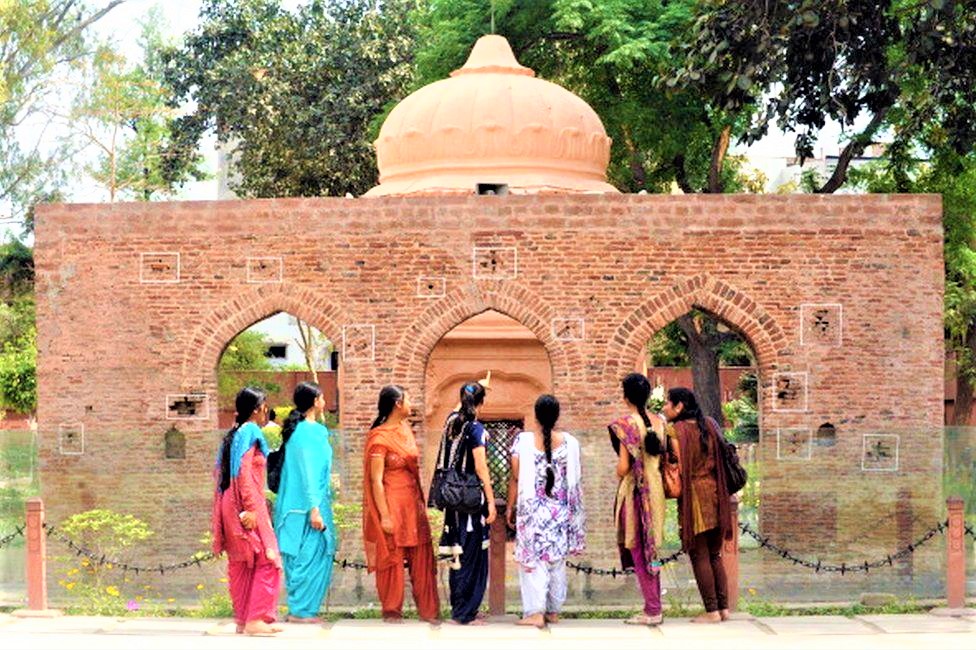
Present day visitors to Jallianwala Bagh, shown the large caliber bullet holes in the wall at the site of the civilian massacre by the British on 13th April 1919
This callous state can only materialise if the shooters, as humanoids do not have the innate proclivity towards the pursuit of compassion, in killing helpless fellow humans, upon the orders of two Britishers who called themselves civilised. They did not experience intense pain when witnessing the oppression, injustice, violence and abuse. The absence of these feelings, makes themselves sub humans and barbarians be they considered civilized are psychopaths and are immune to humane sentiments. The large-scale slaughter at Jallianwala Bagh is an indelible stain on the entire British nation, even today, since no formal apology has ever been rendered from the British Government, who are equally complicit in the murders of whatever numbers, which were killed, be it 350 or 1000 civilians, the youngest victim was reportedly an eight months old baby.
The real irony was that the British duo who issued the command and the general who executed the “monstrous shooting” were glorified as heroes in Britain and the ire of Udham Singh can be appreciated twenty years later, when a bullet fired by him put an end to the titled Sir for the murder of innocent Indians. Ironically this mentality pf barbaric brutality, displayed by colonial powers in occupied territories is still prevalent, even today.
References:
[1] https://www.thestudyfalcon.com/blog/26-december-birth-anniversary-of-sardar-udham-singh/
[2] https://www.britannica.com/biography/Bhagat-Singh#:~:text=Bhagat%20Singh%20was%20a%20hero%20of%20the%20early,crimes%20in%201931%20at%20the%20age%20of%2023.
[3] https://wikimili.com/en/List_of_governors_of_Punjab_(British_India)
[4] https://en.wikipedia.org/wiki/Atlanto-axial_joint#:~:text=The%20atlanto-axial%20joint%20is%20a%20joint%20in%20the,second%20cervical%20vertebrae.%20It%20is%20a%20pivot%20joint.
[5] https://en.wikipedia.org/wiki/Indian_Rebellion_of_1857
[6] https://icytales.com/how-long-was-british-rule-in-india-an-easy-brief/#:~:text=did%20not%20just%20suck%20all%20the%20wealth%20or%20heritage%2C%20but%20also%20hollowed%20the%20rich%20Indian%20culture
[7] https://www.transcend.org/tms/2022/01/the-partition-of-india-by-the-british-raj-destruction-of-peace-national-cohesion-and-love/
[8] https://www.bing.com/search?q=independence+of+indua+date&cvid=c89554ded78d44aaab0c479380e81df0&aqs=edge..69i57j0.13923j0j1&pglt=43&FORM=ANNTA1&PC=U531
[9] https://en.wikipedia.org/wiki/Indira_Gandhi
[10] https://www.historyextra.com/period/20th-century/interview-anita-anand-aftermath-amritsar-massacre-udam-singh/
[11] https://en.wikipedia.org/wiki/Udham_Singh#:~:text=Anand%2C%20Anita%20(2019).%20%223.%20Birth%20of%20the%20upheaval%22.%20The%20Patient%20Assassin.%20London%3A%20Simon%20and%20Schuster.%20pp.%C2%A030%E2%80%9343.%20ISBN%C2%A0978%2D1%2D4711%2D7424%2D7
[12] Farina Mir (2010). The Social Space of Language: Vernacular Culture in British Colonial Punjab. University of California Press. p. 16. ISBN 978-0-520-94764-1.
[13] https://revolutionarydemocracy.org/rdv2n2/singh.htm
[14] https://www.bing.com/news/search?q=Hijab+Protests+by+the+Muslim+girls+in+the+province+of+Karnataka&qpvt=Hijab+Protests+by+the+Muslim+girls+in+the+province+of+Karnataka&FORM=EWRE
[15] https://en.wikipedia.org/wiki/Majha
[16] https://www.bing.com/search?q=Guru+Ram+Das%2C+the+fourth+Sikh+guru+is+credited+with+founding+the+holy+city+of+Amritsar+in+the+Sikh+tradition&aqs=edge..69i57.441654j0j4&pglt=43&FORM=ANNTA1&PC=U531#:~:text=Ram%20Das%20Sahibji-,Guru%20Ram%20Das%20Sahibji%20was%20the%20fourth%20Guru%20in%20the%20Sikh%20tradition.%20He%20is%20credited%20with%20founding%20the%20holy%20city%20of%20Amritsar%20(earlier%20known%20as%20Ramdaspur%20or%20%E0%A4%B0%E0%A4%BE%E0%A4%AE%E0%A4%A6%E0%A4%BE%E0%A4%B8%E0%A4%AA%E0%A5%81%E0%A4%B0).%20He%20was%20an%20accomplished%20poet,-and%20638%20of
[17] https://en.wikipedia.org/wiki/Mahatma_Gandhi
[18] https://en.wikipedia.org/wiki/Satyagraha
[19] https://www.historyireland.com/repression-the-amritsar-massacre-1919-the-irish-connection/
[20] https://nationaltoday.com/ram-navami/
[21] https://www.indiatimes.com/explainers/news/dr-saifuddin-kitchlew-hero-jallianwala-bagh-559413.html
[22] https://www.historyireland.com/repression-the-amritsar-massacre-1919-the-irish-connection/#:~:text=On%209%20April,to%20take%20control.
[24] https://www.getbookfast.com/now/dr-satyapal-the-hero-of-freedom-movement-in-the-punjab/
[25] https://en.wikipedia.org/wiki/Jallianwala_Bagh_massacre
[26] https://www.bing.com/search?q=rowlatt+act+1919&cvid=af306bdcd9614f8696c3699e953873a7&aqs=edge.1.0l9.8624j0j1&pglt=43&FORM=ANNTA1&PC=U531#:~:text=in%20new%20tab-,Rowlatt%20Act%2C%201919,-Long%20Title
[27] https://www.britannica.com/event/Jallianwala-Bagh-Massacre
[28] Nigel Collett (15 October 2006). The Butcher of Amritsar: General Reginald Dyer. A&C Black. p. 263. ISBN 978-1-85285-575-8.
[29] Dolly, Sequeria (2021). Total History & Civics 10 ICSE. New Delhi: Morning Star. p. 71.
[30] India. Committee on Disturbances in Bombay, Delhi, and the Punjab (1920). Report; disorders inquiry committee 1919–1920. pp. XX–XXI, 44–45, 116–7.
[31] https://www.ndtv.com/india-news/baisakhi-history-importance-significance-date-celebrations-2022284
[32] Collett, The Butcher of Amritsar p. 252-253
[33] https://en.wikipedia.org/wiki/Jallianwala_Bagh_massacre#:~:text=Collett%2C%20The%20Butcher%20of%20Amritsar%20p.%20253
[34] https://en.wikipedia.org/wiki/Jallianwala_Bagh_massacre#:~:text=Collett%2C%20The%20Butcher%20of%20Amritsar%20p.%20254%2D255
[35] Collett, The Butcher of Amritsar p. 254-255
[36] India. Committee on Disturbances in Bombay, Delhi, and the Punjab (1920). Report; disorders inquiry committee 1919–1920. pp. XX–XXI, 44–45, 116–7.
[37] https://en.wikipedia.org/wiki/Jallianwala_Bagh_massacre#:~:text=%5E-,Colvin%2C%20p.%20178,-%5E
[38] https://theprint.in/india/all-you-want-to-know-about-303-the-rifle-being-phased-out-after-75-yrs-of-service/354915/#:~:text=The%20Lee%E2%80%93Enfield%20rifle%2C%20commonly%20known%20as%20the.303%20SLME,both%20World%20War%201%20and%20World%20War%20II.
[39] Nigel Collett (15 October 2006). The Butcher of Amritsar: General Reginald Dyer. A&C Black. p. 262. ISBN 978-1-85285-575-8.
[40] https://en.wikipedia.org/wiki/Jallianwala_Bagh_massacre#:~:text=Collett%2C%20The%20Butcher%20of%20Amritsar%3A%20General%20Reginald%20Dyer%20p%20255%2D58
[41] “Punjab Disturbances: The Case of General Dyer”. Parliamentary Debates (Hansard). House of Lords. 19 July 1920. col. 254
[42] Collett, Nigel (2006). The Butcher of Amritsar: General Reginald Dyer. Hambledon Continuum: New Edition. p. 254-255
[43] https://gknotebook.com/the-hunter-commission-1919/#:~:text=Hunter%20Commission%201919%20Hunter%20Commission%201919%20On%2014,formed%20to%20investigate%20the%20Jallianwala%20Bagh%20Massacre%20event.
[44] https://en.wikipedia.org/wiki/Jallianwala_Bagh_massacre#:~:text=Dipankan%20Bandopadhyay%20(15%20April%202020).%20%22Bloodbath%20on%20the%20Baishakhi%22.\
[45] Collett, Nigel (2006). The Butcher of Amritsar: General Reginald Dyer. Amritsar (India): Continuum International Publishing Group. pp. 333–334. ISBN 9781852855758.
[46] https://byjus.com/free-ias-prep/hunter-commission-report/
[47] https://en.wikipedia.org/wiki/Chimanlal_Harilal_Setalvad#:~:text=Sir%20Chimanlal%20Harilal%20Setalvad%20KCIE%20%28July%201864%20%E2%80%93,Bombay%20High%20Court%20in%20the%20early%2020th%20century.
[48] “Evidence Taken before the Disorders Inquiry Committee- Volume III- Amritsar”. UK Parliament.
[49] Winston Churchill (8 July 1920). “Winston Churchill’s speech in the House of Commons”.
[50] https://en.wikipedia.org/wiki/Third_Anglo-Afghan_War
[51] Swami, Praveen (14 November 1997). “THE QUEEN’S VISIT | The Queen in Amritsar”. Wayback Machine. Archived from the original on 6 March 2014.
[52] Burns, John F. (15 October 1997). “In India, Queen Bows Her Head Over a Massacre in 1919”. The New York Times.
[53] https://www.cbc.ca/news/world/jallianwala-bagh-british-soldiers-massacre-amritsar-india-1.5097108
______________________________________________
In Part 2 the author discusses other atrocity committed by the imperial British colonisers in recent history.
 Professor G. Hoosen M. Vawda (Bsc; MBChB; PhD.Wits) is a member of the TRANSCEND Network for Peace Development Environment.
Professor G. Hoosen M. Vawda (Bsc; MBChB; PhD.Wits) is a member of the TRANSCEND Network for Peace Development Environment.
Director: Glastonbury Medical Research Centre; Community Health and Indigent Programme Services; Body Donor Foundation SA.
Principal Investigator: Multinational Clinical Trials
Consultant: Medical and General Research Ethics; Internal Medicine and Clinical Psychiatry:UKZN, Nelson R. Mandela School of Medicine
Executive Member: Inter Religious Council KZN SA
Public Liaison: Medical Misadventures
Activism: Justice for All
Email: vawda@ukzn.ac.za
Tags: British Colonialism, British empire, India
This article originally appeared on Transcend Media Service (TMS) on 14 Feb 2022.
Anticopyright: Editorials and articles originated on TMS may be freely reprinted, disseminated, translated and used as background material, provided an acknowledgement and link to the source, TMS: Barbarism Practised by the Epicentre of Civilisation (Part 1), is included. Thank you.
If you enjoyed this article, please donate to TMS to join the growing list of TMS Supporters.

This work is licensed under a CC BY-NC 4.0 License.
